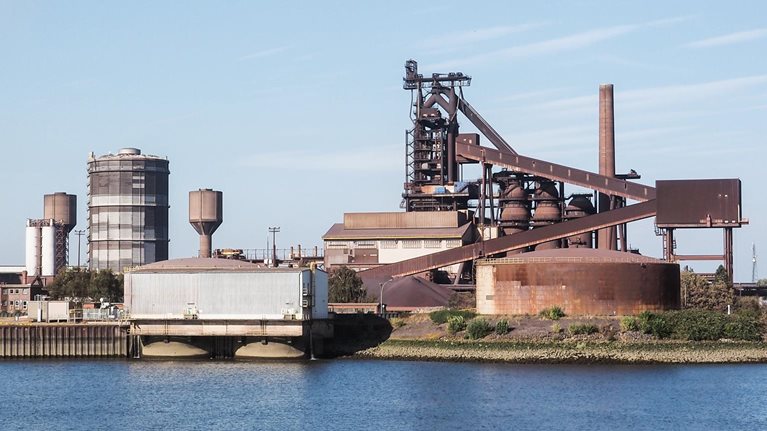The Netherlands can be a leader in innovation for the technologies needed to decarbonize. It has tangible opportunities to accelerate the reduction of CO2 emissions, in line with its climate targets. And it has the robust institutions required to undertake the balancing act of simultaneously addressing “decarbonization” and issues of affordability, security of supply, and competitiveness. This report highlights five “forward-leaning moves” (“the what”) that could profitably address decarbonization, and it introduces six “unlocks” (“the how”) that could accelerate the country’s decarbonization journey while driving economic growth.
Climate targets force the country to accelerate progress. In 2021, the Netherlands increased its targets to align with Europe’s “Fit for 55,” aiming for a 55 percent greenhouse-gas reduction by 2030 compared to 1990 levels, with additional targets in 2035 (70 percent) and 2040 (80 percent) to reach net-zero emissions in 2050. For the Netherlands to achieve this ambitious target, the country would need to accelerate from a decline of two metric megatons of CO2 equivalent (MtCO2e) per annum (the average pace from 2000 to 2018) to six MtCO2e per annum. Adding strain to the decarbonization agenda is the relatively high share of hard-to-abate emissions (41 percent) compared with other European countries (for example, 25 percent in Germany and 31 percent in the United Kingdom). Achieving—or even moving toward—net-zero emissions would require sustained efforts and investments across all sectors.
A decarbonization journey will require careful trade-offs to address the balancing act of decarbonization and issues of affordability, security of supply, and competitiveness. The past two years have shown how high energy prices can jeopardize the viability of energy-intensive industry (which accounts for about 18 percent of the Dutch economy and 1.6 million jobs) and affordability for Dutch households. High energy prices have been a factor in (temporary) shutdowns of multiple industrial plants.
Significant investments are needed, and costs could be lowered through innovation. Our analysis shows that the hypothetical net-zero pathway will require about €750 billion in incremental capital expenditures by 2050. These expenditures equate to about 3 percent of GDP annually and are 13 percent above current investment levels. This level of investment can be compared with the construction of the Deltawerken in the Netherlands, which reached 4 percent of GDP per year in the 1970s.1 Lower operating costs from more-efficient technologies would only partly offset this cost by 2050. Innovation can and should be the engine that delivers cost savings from learning rates and economies of scale. The good news is that nearly 80 percent of the abatement needed by 2030 could come from two sets of technologies: those that are mature, such as widely deployed and commercially viable heat pumps, and those in earlier stages of adoption, such as electric cars (Exhibit 1).
The Netherlands has the opportunity to make five ‘forward-leaning moves’
These moves have high upside potential and could contribute to profitably solving the decarbonization equation. This is provided that innovation continues to drive technology costs down in line with current expectations. In line with the country’s emissions split, this list of moves is skewed toward the power and industrial sectors, given these sectors account for 65 percent of the total country emissions. This does not mean other areas such as buildings and agriculture don’t also need to significantly step up their efforts.2 These forward-leaning moves can significantly reduce the emissions of hard-to-abate segments while also boosting the Dutch economy by creating jobs, growing GDP, and creating new opportunities of (export) market value. They may also safeguard the value of existing Dutch players and their contribution to GDP and jobs.
We defined the following list of forward-leaning moves as a starting point for collective, collaborative action (Exhibit 2):
A circular plastics cluster with the potential to eliminate plastic waste and enable the transition to a circular value chain. To keep up with changing consumer demand, increasingly ambitious country targets, and tightening regulation and legislation, the plastics value chain will need to shift from using fossil fuels and being linear to being circular. This opportunity is especially relevant for the Netherlands because the country is home to leading companies from across the entire plastics ecosystem, as well as plastic capture infrastructure and specialized talent. As a large exporter of both plastics and end products, the Netherlands could create €2 billion to €4 billion of (export) market value and reduce emissions by ten to 12 MtCO2e per annum by 2035 by establishing a circular plastics cluster. Of the five forward-leaning moves identified, this one probably has the most mature market; some recycling businesses are already operating profitably at scale.
A sustainable-fuels hub to help decarbonize commercial transport. The Netherlands’ density of existing infrastructure and industrial players, including the Port of Rotterdam and Schiphol Airport, could allow it to become a sustainable-fuels hub while solidifying its role as a leading logistics gateway to Europe. By producing and distributing bio-based and synthetic fuels, the country could potentially abate three to four MtCO2e per annum and create €1.5 billion to €2.8 billion of (export) market value annually by 2035.
Clean-hydrogen infrastructure powered by an additional ten gigawatts (GW) of offshore wind energy. To unlock the next wave of decarbonization in energy-intensive industries (such as iron, steel, fertilizer, and refining), the Netherlands would have to competitively produce ten GW of clean hydrogen by 2035. Key investments in clean hydrogen could reduce emissions by ten to 20 MtCO2e per annum. To produce affordable, clean hydrogen, significant cost-competitive renewable power is required. This forward-leaning move is therefore a difficult one.
Initial green hydrogen projects show that the cost of green hydrogen is three to four times higher than gray hydrogen (hydrogen produced from gas). Most users of hydrogen (that is, industrial companies) are competing on a global scale, often with low margins on their products. As a result, higher costs would affect their profitability. A careful trade-off between competitiveness and decarbonization is needed.
A carbon capture and storage center that can theoretically abate 1,000 MtCO2 across Northwest Europe. Carbon capture and storage (CCS) has considerable potential as an effective and temporary option for reducing emissions, particularly in hard-to-abate sectors, such as chemicals and petrochemicals, steel, and cement—especially if carbon costs further increase in line with EU policies. CCS could also potentially unlock zero-emission horizons for technologies, such as (blue) hydrogen and plastics. The Netherlands has one of the best CCS cost positions in Europe through its vast offshore storage capacity. A CCS center could create €2 billion to €3 billion of (export) market value per year and reduce emissions by ten or more MtCO2e per annum by 2035. And the theoretical potential is significant: the Netherlands could be storing up to a cumulative 1,000 MtCO2—almost six times the current total annual emissions.
A more flexible power system enabling decarbonization. Power is core to all economic activities and needs to stay affordable while becoming more green. The Dutch power system is moving toward an intermittent system—that is, a system powered by renewable energy sources such as solar and wind whose output varies materially over time. To scale up the penetration of renewable power while maintaining flexibility in varying demand for power during the day, flexibility solutions need to be better integrated. These solutions could include energy storage, power to heat conversion, or even hydrogen production during periods of oversupply.
In parallel, the Netherlands could consider introducing more-granular bidding zones and co-locating supply and demand to avoid network constraints in the short term. Adding renewables combined with more-flexible power solutions would allow the Netherlands to cut emissions by as much as ten to 20 MtCO2e per annum by 2035. This forward-leaning move is different in that it enables the others; green power is a prerequisite to making other sectors greener.
Six ‘unlocks’ can accelerate the country’s decarbonization journey
Identifying what needs to happen is only the first step. To move from ambition to action requires a step change in existing public and private frameworks. Six unlocks can support this shift (Exhibit 3):
Shift from planning to problem solving. The pace and scale of the transition needed to decarbonize should not be underestimated. Tight coordination across value chains, clear signaling of policy intentions, and agility in decision making will be critical success factors in achieving targets. Doing so will provide the right incentives for innovative players. There is no one plan that will work, and any plan will need to be updated continuously as circumstances change. It is most important to start solving the problems that are currently impeding progress.
Radically solve for economy-wide bottlenecks. The Netherlands, known for innovation, faces significant challenges in its journey toward decarbonization. These challenges, including permitting rules, labor market shortages, access to critical components, and balancing the nitrogen budget, are limiting its efforts to decarbonize the economy. Resolving these challenges requires proactive and determined decision making across the public and private sectors.
Signal and derisk through infrastructure development. Currently, many emitters face difficulties with their energy transition plans due to uncertainty about, for example, the timely availability and usage costs of infrastructure. Governments could create clarity throughout the value chain with targeted interventions, such as by taking the lead on or investing in critical infrastructure, as it has done successfully in the past (for example, the gas network, power grid, and water system), and creating regulation to encourage the development of new value chains.
Rethink the approach to risk. Governments and companies may want to rethink their definition and perception of risk. Leaders may want to not only evaluate the inherent risk around green investments but also explicitly weigh the risk of not investing.
Develop innovative transition finance opportunities. Financial institutions have an important role to play in helping structure the required funding and accelerating access to capital, when needed. There is a significant opportunity for financial institutions that get it right. By strategically allocating capital, these institutions could clarify which developments they want to support, while also offering support mechanisms. Moreover, developing innovative transition finance opportunities will help financial institutions meet their commitments.
Secure a support base among stakeholders. Developing support for the decarbonization agenda across stakeholders might be the most vital action—and the most complex. This requires clearly communicating about the consequences of inaction, increasing affordability (including through innovation support as highlighted above), clarifying the contributions expected from various stakeholders, and finding the line between preserving the interests of stakeholders directly affected and achieving decarbonization in the Netherlands.
While delivering on the above inherently requires political leadership from governments, building support for the decarbonization journey is not exclusively a public task. Nongovernmental organizations, the financial sector, and industry will need to work toward this together. Investing in aligning communication wherever possible can help projects gain acceptance, especially those that mobilize both private and public resources.
In this moment, it comes down to the importance of making any kind of progress—moving from ambition to action.


